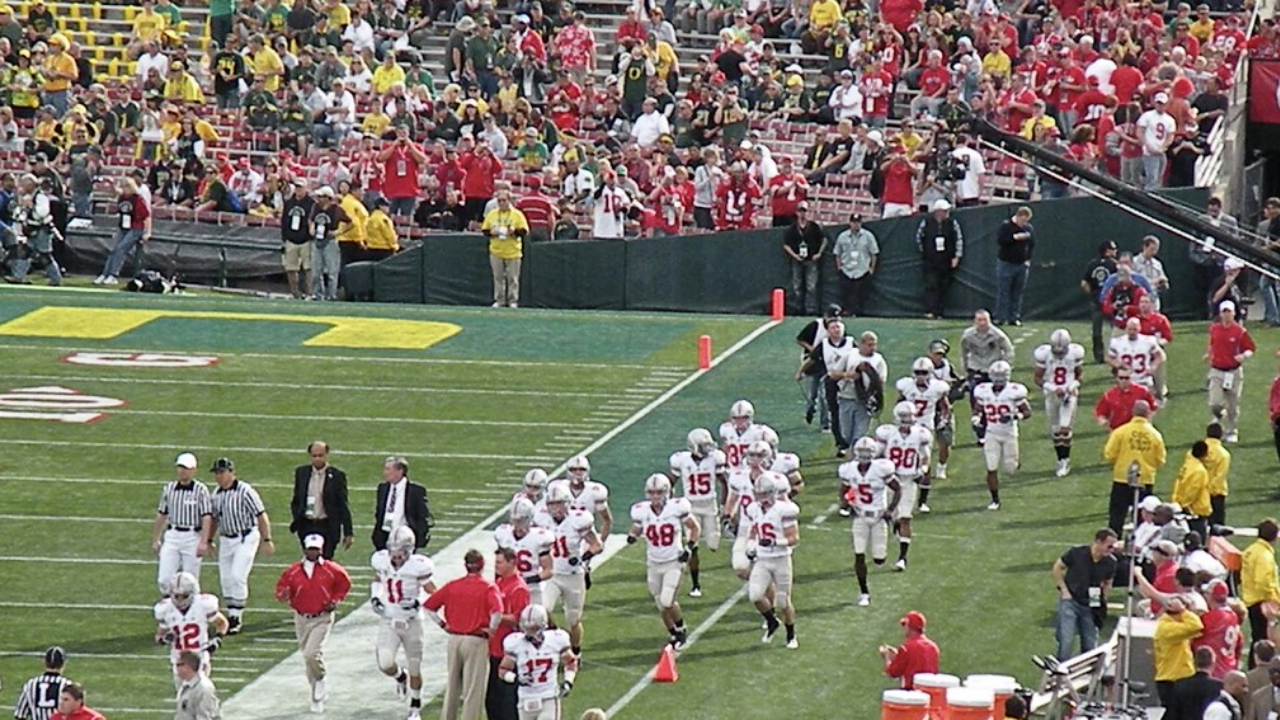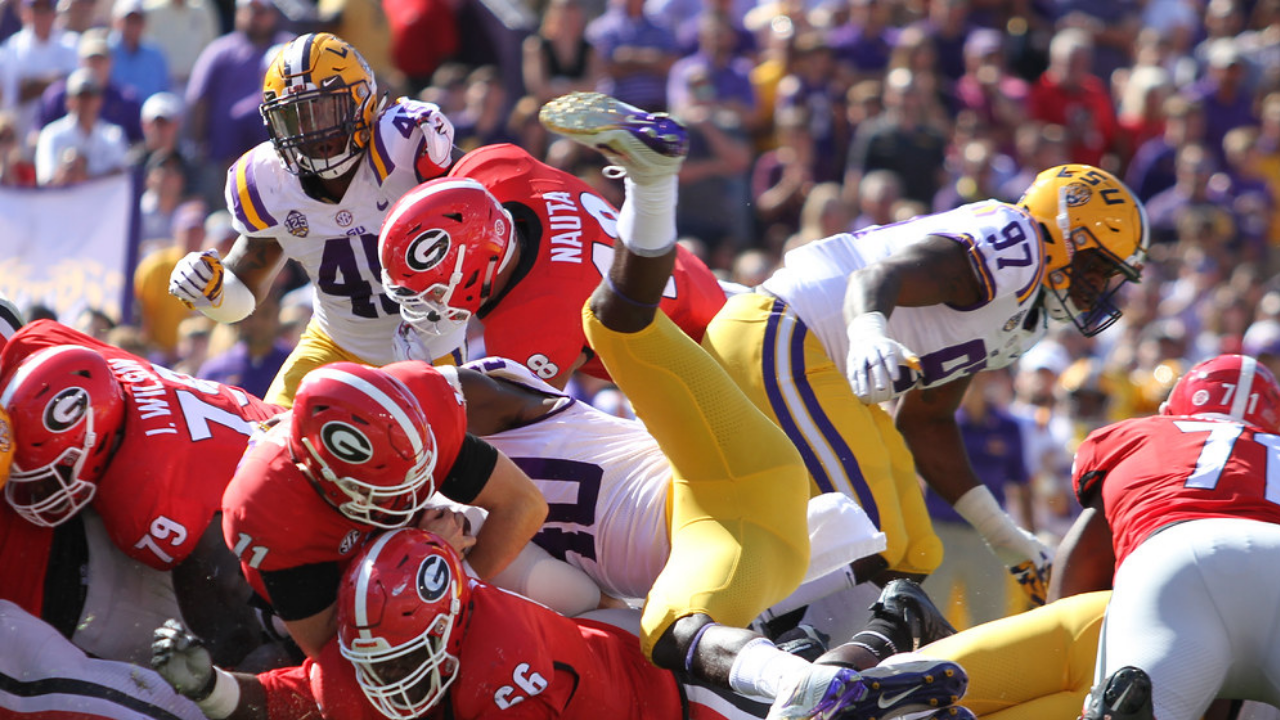SEC versus BIG Ten, Who Is the Premier College Football Conference
The power players in college football remain the same despite rapidly evolving conference realignment, transfer portal movement, and NIL deals. Schools like Alabama, Georgia recently, Ohio State, Michigan, and a handful of others still remain at the apex of the sport, leagues above other schools and athletic departments who claim to be blue bloods in college football. However, it may seem as though the paradigm of power has finally shifted, leaving the once dominant Southeastern Conference scratching its head - at least, this is what OSU fans would have you believe.
Two CFP National Championships in a Row Aren’t Anything to Scoff At
Credit: Flickr, Matthew D Britt
The SEC, led by the Alabama Crimson Tide, has absolutely been the premier conference in college sports over the last two decades. Although not limited to college football, thanks to six National Championships from famed Head Coach Nick Saban and the Alabama Football team, the SEC, along with Florida, Auburn, LSU, and Georgia, who marched on the scene in the late 2010s much like Sherman’s rage-filled march down to Savannah, the conference has enjoyed a steady pace of dominance over the rest of their college football brethren.
RELATED: Alabama Football Heating Up: Tide in the Running for Four Elite Recruits
In fact, since 2003, the SEC, now including Texas and Oklahoma, has won a staggering 15 national titles. That’s 15 out of 20, only leaving a few scraps to USC in 2005, FSU in 2013, Michigan, and Clemson in 2016 and 2018. What’s even more impressive is that three of those National Title games still had SEC representation in Alabama and Auburn. Even better, two of the title games were an all-SEC affair in Alabama versus LSU and Georgia versus Alabama. However, despite the sense of superiority SEC fans feel when it comes to football played on Saturdays, the SEC hasn’t sniffed a title in two years, with the closest competitors being the ole reliable Georgia Bulldogs and Alabama Crimson Tide.
The last two National Titles, the last four-team College Football Playoff champion and the first twelve-team College Football Playoff champion, have come from the BIG Ten conference. In early 2024, Michigan took down the famed Crimson Tide to march on to a relatively comfortable National Title win over the Washington Huskies, while Ohio State enjoyed a slaughter-fest through the newly formatted 12-team playoff to win their first title in 10 years. The cherry on the top of the cake was Alabama, once again (in the same year) losing to the Michigan Wolverines in their bowl game.
SEC Dominance Hasn’t Gone Anywhere
Credit: Flickr, UA 2010
It was indeed a weird couple of years in college football. The SEC, in its entirety, brought on two new teams in the Texas Longhorns and Oklahoma Sooners, while the Big Ten brought in a few new faces heralded by Dan Lanning and the Oregon Ducks, who made quite an entrance at Big Ten media days last summer. NIL has expanded the strategy for many schools, upping their chances of making the big dance, and the media has become frustrated with the SEC storyline. Although the majority of media who cover college football outside of the south would tell you that the SEC’s dominance over college football is over, those who aren’t suffering from conference fatigue might be more cautious to make such an incredulous claim against a conference who has had a stranglehold on the sports for the better part of two decades.
RELATED: Alabama Head Coach Kalen DeBoer Offers Starting Quarterback Insight
The most interesting aspect at play here is money, although the emergence of pay-for-play in college football is nothing new, Big Ten fans believe wholeheartedly that the SEC can’t keep up when it comes to NIL. Although that may be true to an extent, a few schools absolutely can: Alabama, Texas, Texas A&M, Auburn, Tennessee, and Georgia, to name a few. To insinuate that finances would be the thing to keep the SEC down would be a ridiculous and near-sighted argument, especially considering that OSU just won a National Championship with a plethora of SEC transfers, including star defensive back Caleb Downs (Alabama) and running back Quinshon Judkins (Ole Miss). Players who likely were taking checks at their first locations.
Ohio State’s Unsustainable Model
Credit: Flickr, The Ohio State
The actual truth, money aside, is that it has become harder than ever to win a National Championship, especially in the SEC. Looking at Georgia’s strength of schedule in 2024, they were easily nestled in the Top 10 toughest schedules in college football. While Ohio State sat right behind them. However, when you look at where they ranked at their lowest, Georgia’s SOS got no lower than 9 during the regular season, while OSU dropped down to 56 at one point. What’s my meaning? Well, it’s much easier to beat yourself up and play yourself out of contention when you’re facing Florida, Texas, and Alabama during the regular season as opposed to Maryland, Northwestern, and Purdue.
To even sail safely through that mediocre schedule, Ohio State had to spend an unimaginable amount of money - reportedly to the tune of $20 million. That’s not to say Georgia and Alabama, the notable powers in the SEC aren’t spending their fair share, but to lore the SEC talent away, Ohio State seems to have depended on an unsustainable model for success, a model one SEC team is taking to new extremes in 2025.
Thanks to the “spend more, win more” perception that Ryan Day and Ohio State have now published across the college football landscape, Texas, now an SEC school, has reportedly spent between $30-$45 million on their 2025 roster, an amount even their own administration admits is not “sustainable.” This news, along with long talks from Nick Saban on Capitol Hill, has led to President Donald Trump creating a College Sports commission, which will do what the NCAA won’t and research and investigate the spending, presenting probably fixes for the sport’s faulty and shady landscape as of today.
Strong Every Ten Years
Credit: Flickr, Eleven Warriors
Winning the first new-look National Championship is nothing new for Ohio State. In 2014, they won the first ever four-team College Football Playoff, running down Alabama’s throat in the semi-final, eventually throttling the Oregon Ducks (who have never won a national championship). However, after that shining moment, the Buckeyes only ever sniffed the playoff again a couple of times, losing to Washington, Clemson, Alabama, and Georgia during their other appearances.
To be honest, OSU, since their last National Championship, has struggled to even beat their in-conference rival in recent years, losing their last four to Michigan. None of this is to say that Ohio State isn’t a premier program, but to call two national titles in 10 years, “the new Alabama,” is stretching the truth about as far as you can. Alabama has a nasty, unprecedented story of dominance over the last two decades, one that is likely untouchable in the new era of college football.
Lackluster Bowl Games Don’t Matter in the Grand Scheme of Things
Credit: Flickr, Tammy Anthony Baker
Michigan’s win over Alabama in the bowl game was a huge moment for the program, but it doesn’t automatically mean the Big Ten is better than the SEC. One game—especially a tightly contested one—can’t represent the strength of an entire conference. Bowl games often feature unique circumstances, such as extended preparation time, player opt-outs, and coaching changes, all of which can affect performance. While Michigan’s victory was impressive, it was a single data point, not a comprehensive measure of conference superiority.
The SEC's dominance over the past two decades isn’t built on one-off results but on sustained success at the national level. Programs like Alabama, Georgia, and LSU have won numerous national titles, routinely dominate NFL draft boards, and maintain depth and talent across the board. The Big Ten has strong programs too, but outside of Ohio State and now Michigan, few have consistently competed at the highest level. A single postseason win doesn’t erase the broader track record of the SEC’s depth and top-end success.
Moreover, the structure of bowl matchups often distorts fair comparisons. The SEC frequently sends its best teams into high-stakes games where their opponents are just as talented or more motivated. Alabama was playing in a semifinal but had endured a grueling SEC schedule, which wears teams down. Meanwhile, Michigan came in healthy and focused. While Michigan absolutely earned its win, judging entire conferences based on one game ignores the week-in, week-out challenges that define a conference’s true strength.
2025 will be an interesting year to figure out who is the reigning or new king of college football, but if I were a betting man, my money would remain with the SEC. Although the Big Ten boasts competitors like OSU, Michigan, Penn State, and Oregon, the real choices are the first two named. However, the SEC brings with them several real National Championship threats in 2025 - Alabama, Georgia, LSU, Tennessee, Texas, and even Ole Miss. We’ll see how the proverbial cookie crumbles, I guess.







